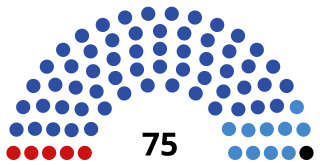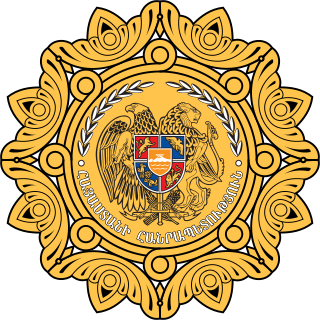| Part of a series on the |
| Albanian Constitution |
|---|
 |
| Albania |
| Preamble |
| Parts of the Constitution |
| Referendums |
Part Five (Part V) of the Constitution of Albania is the fifth of eighteen parts. [1] Titled The Council of Ministers, it consists of 13 articles.
| Part of a series on the |
| Albanian Constitution |
|---|
 |
| Albania |
| Preamble |
| Parts of the Constitution |
| Referendums |
Part Five (Part V) of the Constitution of Albania is the fifth of eighteen parts. [1] Titled The Council of Ministers, it consists of 13 articles.
— Article 95 —
1. The Council of Ministers consists of the Prime Minister, deputy prime minister, and ministers.
2. The Council of Ministers exercises every state function that is not given to other bodies of State power or local government
— Article 96 —
1. The President of the Republic, at the beginning of the legislature, as well as when the post of the Prime Minister remains vacant, appoints the Prime Minister on the proposal of the party or coalition of parties that have the majority of seats in the Assembly.
2. When the appointed Prime Minister is not approved by the Assembly, the President appoints a new Prime Minister within 10 days.
3. When even the newly appointed Prime Minister is not approved by the Assembly, the Assembly elects another Prime Minister within 10 days. In this case, the President appoints the new Prime Minister.
4. If the Assembly fails to elect a new Prime Minister, the President of the Republic dissolves the Assembly.
— Article 97 —
The Prime Minister appointed according to Article 96, Article 104 or Article 105 presents to the Assembly for approval, within 10 days, the policy program of the Council of Ministers together with its composition.
— Article 98 —
1. A minister is appointed and dismissed by the President of the Republic, on the proposal of the Prime Minister, within 7 days.
2. The decree is reviewed by the Assembly within 10 days.
— Article 99 —
Before the Prime Minister, deputy prime minister, and ministers take the office, they swear before the President of the Republic.
— Article 100 —
1. The Council of Ministers determines the principal directions of the general state policy.
2. The Council of Ministers takes decisions upon the proposal of the Prime Minister or the respective minister.
3. Meetings of the Council of Ministers are closed. 4. Acts of the Council of Ministers are valid when signed by the Prime Minister and the proposing minister.
5. The Council of Ministers issues decisions and instructions.
— Article 101 —
The Council of Ministers, in cases of necessity and emergency, may issue, under its responsibility, normative acts having the force of law for taking temporary measures. These normative acts are immediately submitted to the Assembly, which is convened within 5 days if it is not in session. These acts lose force retroactively if they are not approved by the Assembly within 45 days.
— Article 102 —
1. The Prime Minister:
- a) represents the Council of Ministers and chairs its meetings;
- b) outlines and presents the principal directions of general state policy and is responsible for them;
- c) assures the implementation of legislation and policies approved by the Council of Ministers;
- ç) coordinates and supervises the work of the members of the Council of Minister and other institutions of the central state administration;
- d) performs other duties prescribed in the Constitution and the laws.
2. The Prime Minister resolves disagreements between ministers.
3. The Prime Minister, in the exercise of his powers, issues orders.
4. The minister, within the principal directions of general state policy, directs, under his responsibility, actions for which he has powers. The minister, in the exercise of his powers, issues orders and instructions.
— Article 103 —
1. Anyone who has the capacity to be a deputy may be appointed a minister.
2. A minister may not exercise any other state function nor be a director or member of the bodies of profit-making companies.
3. Members of the Council of Ministers enjoy the immunity of a deputy.
— Article 104 —
1. The Prime Minister is entitled to present to the Assembly a motion of confidence for the Council of Ministers. If the motion of confidence is voted by less than half of all the members of the Assembly, the Prime Minister, within 48 hours from the voting of the motion, requests the President of the Republic to dissolve the Assembly.
2. The President dissolves the Assembly within 10 days from the receipt of the request. A request for a motion of confidence may not be presented while a motion of no confidence is being examined according to article 105.
3. The voting of the motion may not take place unless three days have passed since its submission.
— Article 105 —
1. One-fifths of the Members of Parliament is entitled to present for voting to the Assembly a motion of no confidence towards the incumbent Prime Minister, by proposing a new Prime Minister.
2. The Assembly may vote a motion of no confidence towards the Prime Minister only by electing a new Prime Minister with the votes of more than half of all the members of the Assembly.
3. The President of the Republic decrees the dismissal of the incumbent Prime Minister and the appointment of the elected Prime Minister not later than 10 days from the voting of the motion at the Assembly.
— Article 106 —
The Prime Minister and the ministers are obligated to stay in office until the appointment of the new Council of Ministers.
— Article 107 —
1. Public employees apply the law and are in the service of the people.
2. Employees in the public administration are selected through competition, except when the law provides otherwise.
3. Guarantees of tenure and legal treatment of public employees are regulated by law.

The Czech Republic is a unitary parliamentary republic, in which the president is the head of state and the prime minister is the head of government. Executive power is exercised by the Government of the Czech Republic, which reports to the Chamber of Deputies. The legislature is exercised by the Parliament. The Czech Parliament is bicameral: the upper house of the Parliament is the Senate, and the lower house is the Chamber of Deputies. The Senate consists of 81 members who are elected for six years. The Chamber of Deputies consists of 200 members who are elected for four years. The judiciary system is topped by the trio of the Constitutional Court, Supreme Court and Supreme Administrative Court.

The president of the Council of Ministers, colloquially referred to as the prime minister, is the head of the cabinet and the head of government of Poland. The responsibilities and traditions of the office stem from the creation of the contemporary Polish state, and the office is defined in the Constitution of Poland. According to the Constitution, the president nominates and appoints the prime minister, who will then propose the composition of the Cabinet. Fourteen days following their appointment, the prime minister must submit a programme outlining the government's agenda to the Sejm, requiring a vote of confidence. Conflicts stemming from both interest and powers have arisen between the offices of President and Prime Minister in the past.

The Government of the Republic of Armenia or the executive branch of the Armenian government is an executive council of government ministers in Armenia. It is one of the three main governmental branches of Armenia and is headed by the Prime Minister of Armenia.
A motion or vote of no confidence is a formal expression by a deliberative body as to whether an officeholder is deemed fit to continue to occupy their office. The no-confidence vote is a defining feature of parliamentary democracy which allows the elected parliament to either affirm their support or force the ousting of the cabinet. Systems differ in whether such a motion may be directed against the prime minister only or against individual cabinet ministers.
The constructive vote of no confidence is a variation on the motion of no confidence that allows a parliament to withdraw confidence from a head of government only if there is a positive majority for a prospective successor. The principle is intended to ensure governments' stability by making sure that a replacement has enough parliamentary support to govern.

The prime minister of France, officially the prime minister of the French Republic, is the head of government of the French Republic and the leader of the Council of Ministers.

The prime minister of Romania, officially the prime minister of the Government of Romania, is the head of the Government of Romania. Initially, the office was styled President of the Council of Ministers, when the term "Government" included more than the Cabinet, and the Cabinet was called the Council of Ministers. The title was officially changed to Prime Minister by the 1965 Constitution of Romania during the communist regime.

The president of Romania is the head of state of Romania. Following a modification to the Romanian Constitution in 2003, the president is directly elected by a two-round system and serves for five years. An individual may serve two terms. During their term in office, the president may not be a formal member of a political party. The president of Romania is the supreme commander of the Romanian Armed Forces.

The National Assembly is the lower house of the bicameral French Parliament under the Fifth Republic, the upper house being the Senate. The National Assembly's legislators are known as députés, meaning "delegate" or "envoy" in English; etymologically, it is a cognate of the English word deputy, which is the standard term for legislators in many parliamentary systems).
Dissolution of a legislative assembly is the simultaneous termination of service of all of its members, in anticipation that a successive legislative assembly will reconvene later with possibly different members. In a democracy, the new assembly is chosen by a general election. Dissolution is distinct on the one hand from abolition of the assembly, and on the other hand from its adjournment or prorogation, or the ending of a legislative session, any of which begins a period of inactivity after which it is anticipated that the same members will reassemble. For example, the "second session of the fifth parliament" could be followed by the "third session of the fifth parliament" after a prorogation, but would be followed by the "first session of the sixth parliament" after a dissolution.

The Italian Parliament is the national parliament of the Italian Republic. It is the representative body of Italian citizens and is the successor to the Parliament of the Kingdom of Sardinia (1848–1861), the Parliament of the Kingdom of Italy (1861–1943), the transitional National Council (1945–1946) and the Constituent Assembly (1946–1948). It is a bicameral legislature with 600 elected members and a small number of unelected members. The Italian Parliament is composed of the Chamber of Deputies, as well as the Senate of the Republic.
The Council of Ministers of the Republic of Poland is the collective executive decision-making body of the Polish government. The cabinet consists of the Prime Minister, also known as the Chairman of the Council of Ministers, the Deputy Prime Minister, who acts as a vice-chairman of the council, and other ministers. The current competences and procedures of the cabinet are described between Articles 146 to 162 of the constitution.

The prime minister of Cambodia is the head of government of Cambodia. The prime minister is also the chairman of the Cabinet and leads the executive branch of the Royal Government of Cambodia. The prime minister is a member of parliament, and is appointed by the monarch for a term of five years. Since 1945, 37 individuals have served as prime minister; 33 as official prime ministers, and 4 in acting capacities. The current prime minister since 2023 is Hun Manet.

The president of the Republic of Artsakh was the head of state and head of government of the de facto Republic of Artsakh.

The State Council of Crimea is the parliament of Russian administered Republic of Crimea. It claims to be a continuation of the 'Supreme Council of Crimea' following a vote by the Ukrainian parliament to dissolve the Supreme Council of Crimea. The Parliament is housed in the Parliament building in the centre of Simferopol.

The Government of Georgia is the supreme body of executive power in Georgia that implements the domestic and foreign policies of the country. It consists of the prime minister—the head of the government—and ministers and is accountable and responsible to the Parliament of Georgia. The current powers and responsibilities of the government are governed by the amendments of the Constitution of Georgia passed in 2017 and 2018. From 14 May 1991 to 9 November 1996, the executive government of Georgia was referred to as the Cabinet of Ministers of the Republic of Georgia.

The Council of Ministers is the principal executive organ of the Government of Italy. It comprises the President of the Council, all the ministers, and the Undersecretary to the Prime Minister. Deputy ministers and junior ministers are part of the government, but are not members of the Council of Ministers.

The Council of Ministers of the Autonomous Republic of Crimea, briefly SovMin, is the executive branch of government of the Autonomous Republic of Crimea, a republic within southern Ukraine that is currently suspended due to Russian occupation of the Crimean Peninsula since February 27, 2014. The Council of Ministers derived its authority from the Constitution and laws of Ukraine and normative acts of the Verkhovna Rada of Crimea which bring them into its competency.
Part Three of the Constitution of Albania is the third of eighteen parts. Titled The Assembly, it is divided into 4 chapters that consist of 22 articles.

The president of Armenia is the head of state and the guarantor of independence and territorial integrity of Armenia elected to a single seven-year term by the National Assembly of Armenia. Under Armenia's parliamentary system, the president is simply a figurehead and holds ceremonial duties, with most of the political power vested in the parliament and prime minister.